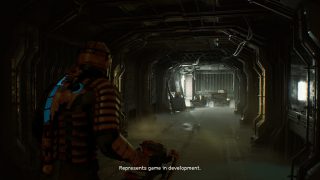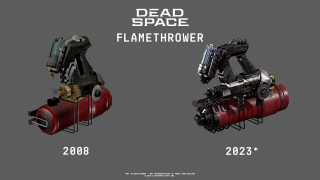Inside Dead Space™ #1: Remaking a Classic
Motive defines what they believe is key to this remake, and their approach to bringing back such a beloved and iconic game.
Defining a remake can be a tricky thing as some remasters get mislabeled as remakes and vice versa. But ask the project leads on Motive’s upcoming remake of Dead Space™ and you’ll hear a clear, unified answer: It’s about rebuilding the game from scratch and adding new content and modern enhancements into the mix—but never, ever betraying the original.
STEP ONE: STAY TRUE
“First, we honor the legacy,” says Senior Producer Philippe Ducharme. “We look at the original game with the utmost respect. So the core foundations will remain the same. However, we are making several enhancements to the experience to make it enticing for both new players and returning ones.”
“And we want the fans of Dead Space to rediscover Dead Space as if for the first time,” says Creative Director Roman Campos-Oriola, “but with everything feeling familiar and recognizable. That’s something that’s really important to us.”
Project Technical Director David Robillard agrees. “It’s a very iconic game for a lot of people,” he says, “and it has a very strong cult following. A lot of people reference it as one of the best in the genre. So we wanted to make sure we understood well what made it the best, and we wanted to make sure we kept that.”

To help ensure that happened, the team took the unusual step of reaching out to the hardest of the hardcore fans as advisors, creating a Community Council to bounce ideas off of. “Really, really early in development,” Roman says, “we started discussions with some members of the community who were identified by our team as diehard fans. We met with them every six weeks, roughly, and we gave them full access to what we were doing.”
“This is not common,” notes David. “In fact, in my experience it’s very rare; I’ve seen only a few other titles do something like this. And I don’t know why it’s very rare, because it seems like every time you do it you get really good results. Go figure, right?”
“Because we have our opinions, but that doesn’t mean we’re right!” Philippe adds. “There were a number of polarizing topics we wanted to get a gut-check on, so we gathered feedback from these groups to make informed decisions. A focus on community is one of the key pillars of this project, so we also took feedback from our livestreams, read through user reviews and Twitch comments—there was a lot of intake of information. It was all to understand who we’re addressing with this game, and what made Dead Space spectacular for them.”
STEP TWO: EXPAND AND ENHANCE
The result is a game that’s much more than a simple modernization of the original. “The story, for example, hits all the main beats and main events of the original,” Philippe says, “but we looked at the lore of the whole franchise, which is a lot wider than the original game. There was Dead Space™ 2, Dead Space™ 3, the comic books—these all added additional lore that we re-injected into the game.”
“Right, we wanted to make it fit better in the overall story and lore of the Dead Space universe that evolved after the first one,” says Roman. “As an example, Isaac has a voice here, just like in Dead Space 2 and Dead Space 3. And some characters who were a bit more secondary, who only appeared in audio logs, like Dr. Cross—we gave them some actual screen time. And we wanted to give a bit more background and agency to some of the characters from the cast, like Nicole. So we’re creating a whole layer of narrative side-quests that will allow you to see, for example, what happened to Nicole during the outbreak.”
And of course there are serious technological enhancements that modern hardware provides. “It’s in a new engine, Frostbite™,” Roman says, “and every asset—every animation, every texture, every effect or piece of enemy behavior—has been rebuilt in the new engine.”

“We’re also actually creating the entire game as one sequential shot,” says Philippe. “From the moment you start the game to the moment you end the game, there are no camera cuts or load screens—unless you die. The Ishimura is now fully interconnected, so you can walk from Point A to Point Z, visit the entire ship, and revisit locations you’ve already completed to pick up things you might have missed—that’s all new. It’s now a completely unbroken experience.”
“How you move around in zero-G is also something we felt we could improve in terms of experience and immersion,” Roman says. “So there’s much more 360-degree freedom; now when you play Dead Space you feel like you’re in space. This also allows us to revisit some of the old content and create new ways to navigate, new paths, and new environments with new challenges.”
“And with the computational power we have now, we’re able to push lighting much, much, much further, “ David adds, “both from a pure lighting perspective and also a shadowing perspective. And the ‘peeling’ and dismemberment system we have now is really cool and it adds quite a bit to our gameplay; it feels more dynamic, more strategic.”
“Right, when you start shooting, you see the skin and the flesh getting ripped from the enemy’s body,” says Roman, “and then you start to see the bones underneath, and then you can cut the bones and it cuts the limb, and so on. It looks amazing—but it also gives direct feedback to the player about the amount of damage they’re doing.”
“And we’re doing a lot with volumetric effects like fog,” says David, “and how that plays with everything: with our shadowing, with our lighting, and also with our physics. We would not have been able to push that at the same level before.”
“Overall, though, we want to make sure people understand that we’re not just going in and enhancing the graphics,” says Philippe, “although that would have been amazing on its own! But it’s also the addition of all the new content, the addition of lore, that kind of depth, to create a new and enhanced experience."
STEP THREE: BRING IT ALL TOGETHER
Even with all that has been added to the game, though, the team never loses sight of their key mission: to honor the legacy of the original Dead Space. “We want to make sure we’re starting with the original, and staying true to that experience,” says Roman, “and then we’re giving you a lot more. The goal was to make you feel like you’re experiencing Dead Space again for the first time, if you were already a fan of the game. But we also have the chance to give people who never played it the opportunity to have the definitive Dead Space experience, with a game that plays, that looks, that sounds like a modern game.”
“Because it was an amazing game,” Philippe says. “And I’m still excited to play it now, with our version. That’s something I know is going to resonate with players today. And I can’t wait for the gaming community to experience that for themselves.”
You’ll have a chance to do just that when Dead Space releases on January 27, 2023, on PlayStation®5, Xbox Series X|S, and PC. Until then, watch this space for more insights from the developers!

